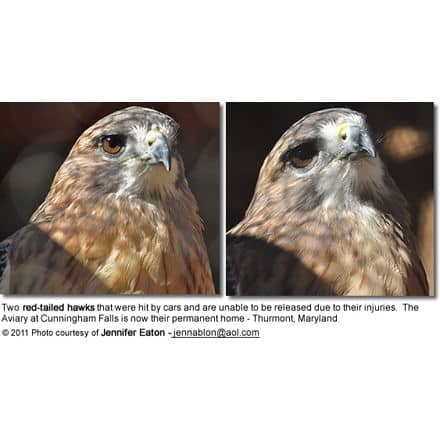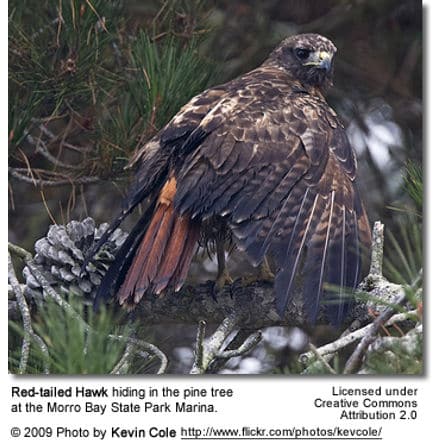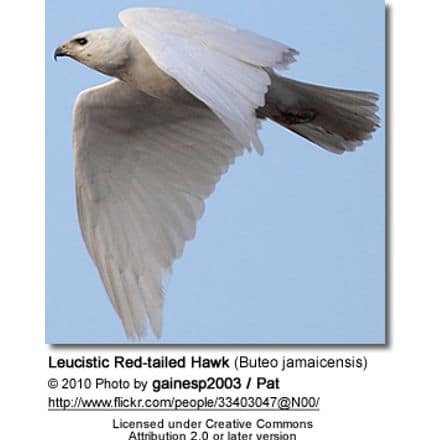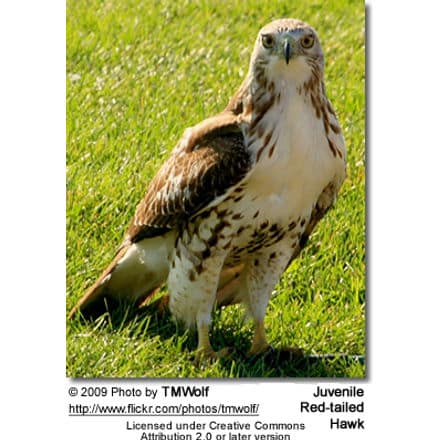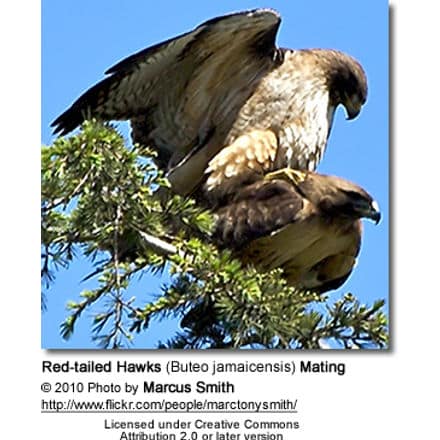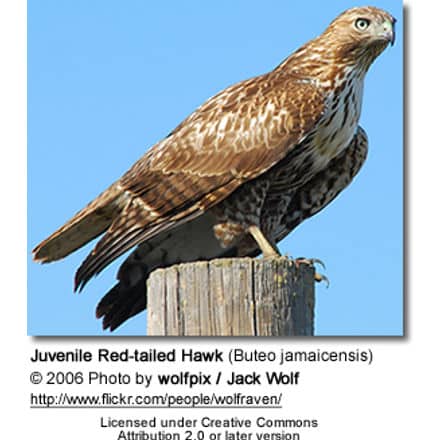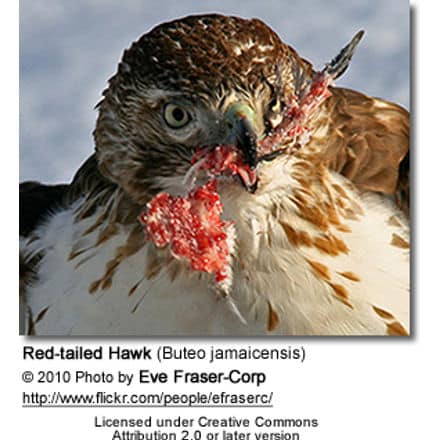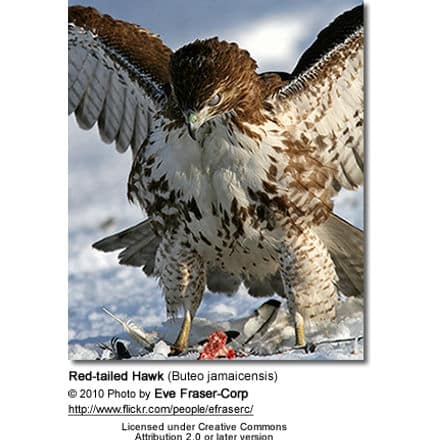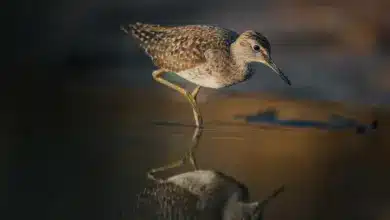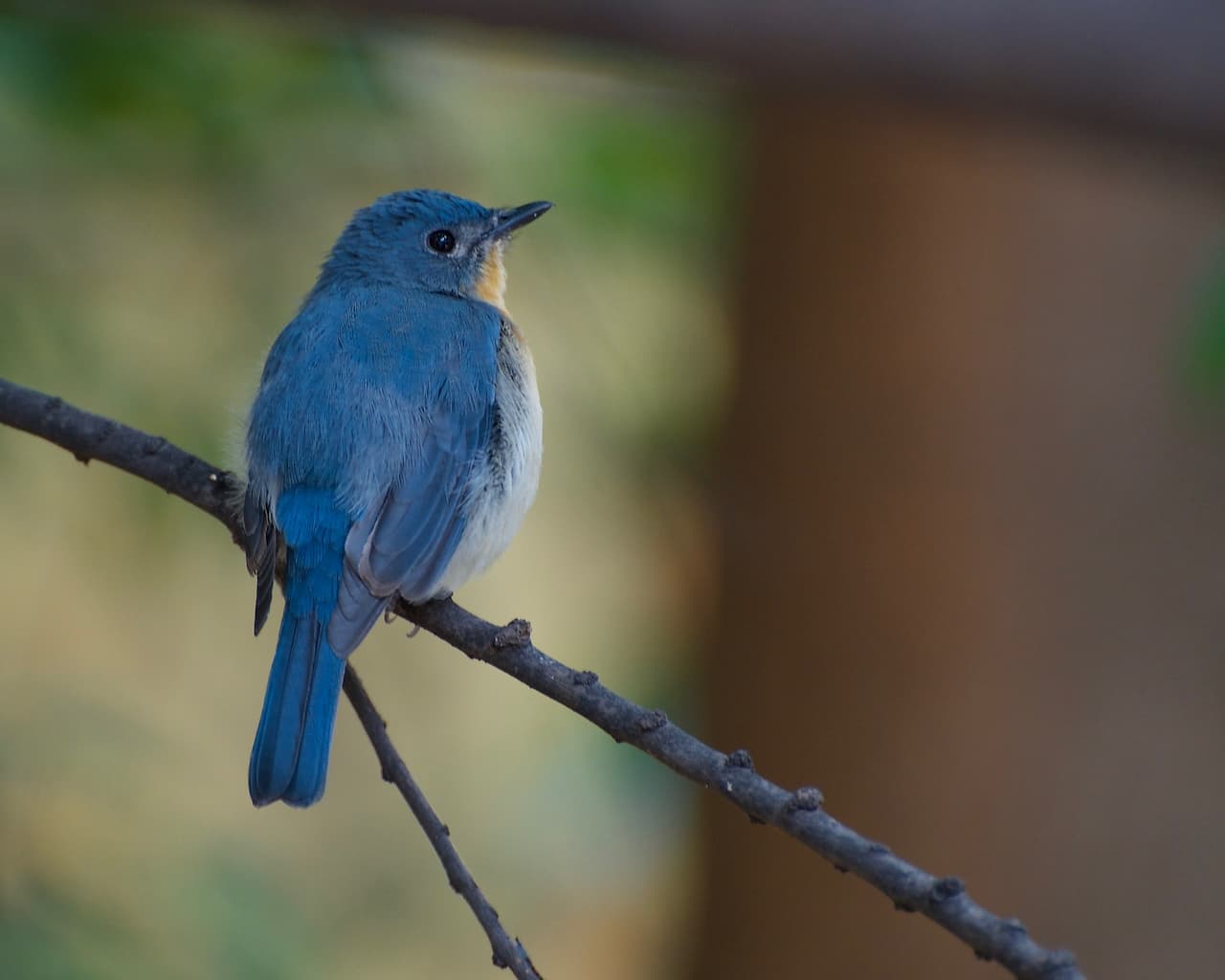Red-Tailed Hawks
The Red-tailed Hawks (Buteo jamaicensis) are birds of prey found in North and Central America, as well as in the West Indies. Throughout their range, they typically live in forests near open country or – depending on their range – in swamps, taigas and deserts.
In North America – where this probably is the most common and widespread hawk species – the Red-tailed Hawk is one of three species colloquially known as the “chickenhawk” or “hen hawk” even though chickens are not a major part of their diet.
They were given this name in earlier times, when free-ranging chickens were preyed upon by first-year juveniles that were too inexperienced to catch more mobile bird species.
Nowadays, as chickens are less commonly kept, they make up only a very small portion of their natural diet.
They are also called buzzard hawks or red hawks.
Red-tailed Hawks are easily recognized by their brick-red colored tails, from which their common name was derived.
In the wild, they are expected to live for 10 -21 years. They reach reproductive maturity when they are about 3 years old.
This species is legally protected in Canada, Mexico and the United States by the international Migratory Bird Treaty Act.
In the United States, they are also protected by state, provincial and federal bird protection laws, making it illegal for anyone to keep hawks without a permit or to hunt them, disturb their nests or eggs – even collecting their feathers is against the law.
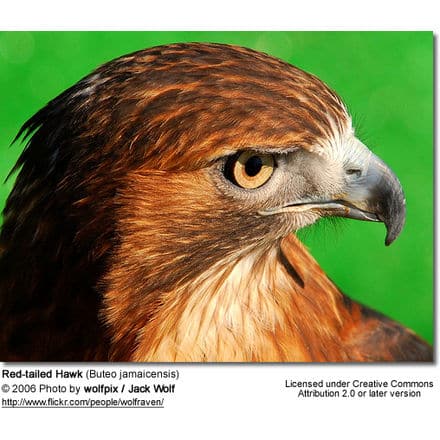
Interesting Facts
- In flight, this hawk travels at speeds from 20 to 40 mph (64 km/h); however, when diving to catch prey, their speed may exceed 120 mph (190 km/h).
- Red-tailed Hawks have a very keen eyesight that is 8 times as powerful as a human’s, allowing them to see prey as small as a mouse from 100 feet (~30 meters) away.
- They have significance in Native American culture; their feathers are considered sacred by some tribes and are used in religious ceremonies.
- They are a very effective at keeping rodent populations down, as 85 – 95% of their diet is composed of small rodents.

Alternate (Global) Names
Danish: Rødhalet Våge …Dutch: Roodstaart Buizerd, Roodstaartbuizerd … German: Rotschwanzbussard … English: Black Warrior, California Hawk, Cooper’s buzzard Hawk, Fuertes’ Hawk, Harlan Hawk, Harlan’s Hawk, Hen Hawk, Krider’s Hawk, red hawk … Latin: Buteo jamaicensis … Estonian: punasaba-viu … Finnish: Amerikanhiirihaukka … French: Buse à queue rousse, Buse de Harlan … Haitian Creole French: Malfini ke wouj … Italian: Poiana codarossa, Poiana della Giamaica … Japanese: akaonosuri … Lithuanian: Raudonuodegis suopis … Norwegian: Rødhalevåk … Polish: myszolów rdzawosterny, myszo?ów rdzawosterny … Russian: ????? ???????? ??? ?????????????, ????????????? ?????, ????????????? ????? … Slovak: Myšiak hrdzavochvostý … Spanish: Águila Colirrojo, Aguililla Cola Roja, aguililla cola-roja, Aguililla Colirroja, Busardo Colirrojo, Gavilán cola roja, Gavilán Colirrojo, Gavilán de Cola Roja, Gavilán de Monte, Guaraguao … Swedish: Rödstjärtad vråk

Distribution / Habitat
The Red-tailed Hawk ranges throughout North America, from western Alaska east to the Yukon, and the Northwest Territories east to southern Quebec and the Maritime Provinces of Canada – through the United States and Mexico, as far south as far as the mountains of Panama and the West Indies.
Those breeding in the northern parts of their range migrate south for the winter. Their wintering range stretches from southern Canada south throughout the remainder of the breeding range.
Those occurring in temperate climates tend to be resident, with only small movements in response to changes in food availability.
They occupy a wide range of habitats and altitudes, including deserts, mountains, grasslands, coniferous and deciduous forests, tropical rainforest, agricultural fields and urban areas
The Red-tailed Hawk can also be found in cities. The non-fiction book Red-Tails in Love: A Wildlife Drama in Central Park by Marie Winn made Pale Male, a Red-tailed Hawk in New York, the most famous urban Red-tailed Hawk.
They can often be seen perched in trees or on poles near open fields or agricultural areas, and along roads.
Red-tailed Hawk Subspecies Ranges and Identification
- Photos of and information about the rehabilitation of an injured Red-tailed Hawk – courtesy of Steve Ware who rescued and cared for this magnificent bird of prey.

Description
Red-tailed Hawks are large, stocky birds. They display sexual dimorphism in size, as females weigh, on average, about 25% more than males.
Length:
The Red-Tailed Hawks measure about 18-26 inches (45 to 65 cm) in length.
Most males are between 18 – 22 inches (45–56 cm) long.
The larger females measure between 19 – 26 inches (48 to 65 cm).
Weight:
They typically weigh between 1.5 – 4.4 lbs (690 – 2000 grams).
The male weighs between 690 to 1300 grams (1.5 to 2.9 pounds).
The female between 2 – 4.4 lbs (900 – 2000 grams)
Wingspan:
Their wingspan is between 38 – 56 inches (1.1 – 1.4 meters)
Anatomy:
- Large, broad-winged, broad-tailed hawk
- Short, dark, hooked beak
- The short, wide tail is square-cut.
- The wings are long and broad.
- The cere, the legs and the feet are yellow.
Plumage
There are geographic variations in the plumage and chest and back pattern- with some birds being intermediate between light and dark morphs. All phases have a darkish band on the leading edges of the inner underwings, known as the ‘patagial’ markings. The tail looks brick-red (rust-colored) above and pink below.
Almost all of the eastern North American population is light-morph, with a whiter under plumage and paler markings than western birds, and with solid brick-red tails. The dark and intermediate morph (genetic mutation) constitutes 10–20% of the population. Rarely, albino (all-white) individuals occur.
Subspecies Differences: Almost all subspecies have some red in the tail. Identification is usually done by the color of the plumage below, the tail markings and size.
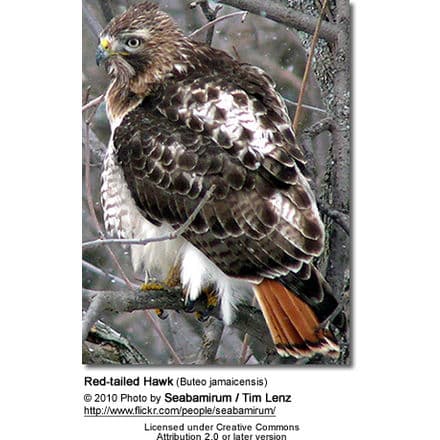
Light morph:
- Brown upper plumage, including head, nape, back and upperwings
- Very pale brown, buff or white chin, throat, chest and abdomen
- Across the abdomen, dark vertical streaks form a mottled ‘belly-band’.
- A faint white ‘V’ on their back-feathers can be seen when they are perched.
- White underwings have dark carpal bar on leading edge, dark outer primary (wing) tips and a dark trailing edge and are otherwise pale with dark bars on the flight feathers on all but the outermost primaries
- The juvenile has less distinct markings below and its brown tail has numerous narrow, dark bands
Dark morph:
- Dark brown plumage overall (above and below), except for the paler underside to primaries (longest wing feathers) and secondaries (shorter, upper “arm” wing feathers)
- The juvenile’s head, neck, chest, back, upperwing and underwing feathers are mottled with white and buff. There are several dark bars on the dark brown tail. The paler flight feathers have dark barring.
In termediate or Rufous-morph:
- Plumage is darker and redder
- The plumage below is reddish-brown rather than white
- The belly band may be barely visible.
Immature Birds
Juveniles have a duller, more streaked plumage and the lack the red tail of the adults (which they attain when they are about two years old).
Immatures have notably narrower wings and tail, and appear slimmer. Their tails are patterned with numerous darker bars.
At close range, they can easily be identified by their yellowish eyes, which darken to reddish-brown as they mature.
Red-tailed Hawk Subspecies Identification and Ranges
Similar Species
Ferruginous Hawk
- Lacks the belly band
- Rufous leggings
- Paler flight feathers and extensive reddish coloration on the upperwing coverts.
Swainson’s Hawk (dark morph)
- Dark flight feathers and white undertail coverts.
Rough-legged Buzzards
- Unmarked flight feathers
- White comma in the outermost underwing coverts
Broad-winged or Short-tailed Hawk (dark morph)
- Smaller in size
White-tailed Hawk
- The juvenile has a white diamond on its central chest.
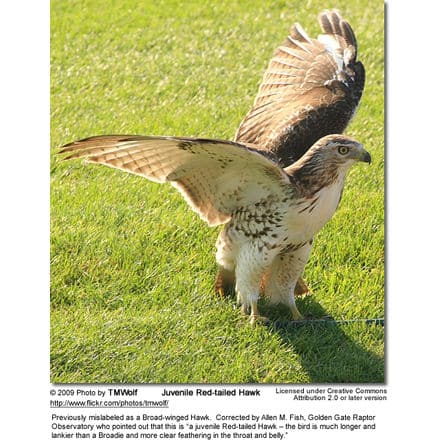
Breeding / Nesting
Red-tailed Hawks are monogamous; remaining with the same mate for life; in general, they will only take a new mate, if their original mate perishes.
A pair defends the same nesting territory for years. Although, outside the breeding season, they may not share the same tree, but remain in the same territory and defend it against intruders.
They typically breed in spring, beginning in March and running through May. Nest building may start as early as January or February.
At the beginning of the breeding season, the male and female fly in wide circles – and uttering shrill screams. The male performs impressive aerial courtship flights, first diving steeply followed by a climb, repeated several times, sometimes grasping the female briefly with his talons (sharp claws).They may even lock talons and spiral towards the ground together for a moment before separating.
The courtship flight can last 10 minutes or more, and is generally followed by the act of mating (copulation). The perching female will allow the male to land on her back. The female twists and moves her tail feathers to one side, enabling the male to twists his cloacal opening around the female’s cloaca.


The nest is typically placed on a very tall tree (4 – 21 meters off the ground) or a cliff (35 meters above the ground). The nest is located near the edge of a stream, lake or field.
They are also known to nest on man-made structures, such as towers, artificial nest platforms and occasionally buildings. Both the male and female build the nest out of sticks and twigs and line it bark shreds, husks, stalks, corn cobs, pine needles and plant material.
The nests may be reused year after year, and as the parents repair and add to it over the years, it can grow up to 3 feet (90 cm) tall.
In March or April, the female lays one or three (occasionally up to five) bluish-white eggs with brown spots. The clutch size depends on the latitude and on the availability of prey (food). An egg is laid every other day until the clutch is complete. Each egg measures about 60 x 47 mm (2.4 x 1.9 in) in size.
The female is primarily responsible for incubating the eggs; however, the male will substitute throughout the day to allow the female to hunt or stretch her wings. The male feeds the brooding female.
The young start hatching after about 28 – 35 days. The nestlings are altricial (naked, blind and helpless). The female broods them while the male brings food to the nest for the female and the young. The female tears the food into small pieces before feeding them to the chicks after tearing the food into small pieces.
The chicks fledge when they are about 42 to 46 days old. The fledging period lasts up to 10 weeks, during which the young learn to fly and hunt. Initially, the young will forage on the ground, looking for small prey, such as insects and spiders. Once they have perfected their flying skills, they will hunt larger prey from the air.
Most juveniles are able to catch their own food 6 to 7 weeks after leaving the nest. Some juveniles stay with their parents for up to six months after they leave the nest.
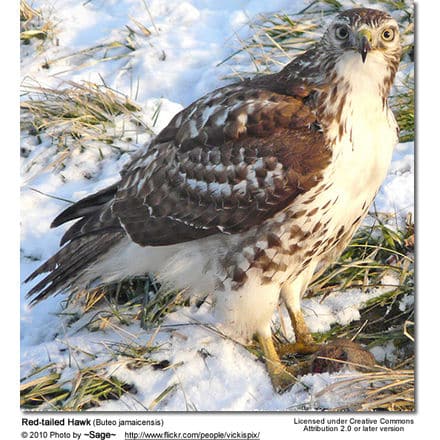
Behavior
When breeding, Red-tailed Hawks are very territorial. They will chase away other Red-tailed Hawks and birds larger than themselves. Approaching a Red-tailed Hawk with nestlings is likely to result in an attack and possible serious injury.
However, outside the breeding season, they are generally non-aggressive toward people or other birds.
They display an aggressive posture; holding the body and head upright while the feathers are standing erect.
Red-tailed Hawks are well adapted for soaring and are often seen soaring in wide circles high over fields, slowly turning on their broad, rounded wings. Their eyes may be fixed on the ground as they look for prey and, when spotted, attack it in a slow, controlled dive with the legs outstretched.
When soaring or flapping its wings, this hawk typically travels from 20 to 40 mph (64 km/h), but when diving may exceed 120 mph (190 km/h). When walking, its steps are slow and awkward.
Calls / Vocalization
While soaring or hunting, the Red-tailed Hawk’s hoarse and rasping 2- to 3-second scream is commonly heard: kree-eee-ar, which begins at a high pitch and slurs downward. This cry is somewhat similar to a steam whistle.
This loud, piercing scream is often featured in the background of adventure movies to give a sense of wilderness to the scene.
Its call is loudest when annoyed or in anger, when a predator or a rival enters its territory.
They also make croaking “guh-runk” sounds. Juveniles utter a wailing klee-uk cry when begging to be fed.

Diet / Feeding
What they eat …
Red-tailed Hawks eat animals that are raccoon-sized or smaller.
~ 85% (up 95%) of their diet is made up of mammals, including rodents (i.e., mice, rats, muskrats, squirrels, etc.), opossums, rabbits, moles, weasels – even pets, like cats and small dogs,
~10% of their diet is made up of birds, such a ducks, pigeons, quail, crows, robins, starlings or woodpeckers.
~ 5% is made up of reptiles and insects, including: snakes, turtles, lizards, salamanders, toads, frogs, fish, crayfish, centipedes, spiders, grasshoppers, crickets, beetles, earthworms, and grasshoppers.
They will also take road kill and other carrion (recently dead, but fairly fresh animals).
Foraging / Hunting Style
Red-tailed Hawks have an excellent sight that is 8 times sharper than that of humans and can see a small mammal, such as a mouse, from a height of 100 feet (30 meters). These efficient hunters can reach high speeds when pursuing prey and have strong talons to grab their prey with. They will also steal food from other raptors (i.e., eagles, owls or other hawks).
They will take prey from the size of a beetle to mammals twice the weight of most Red-tails. The average captive Red-tail Hawk eats about 135 g (4-5 oz) daily.
In flight: When spotting prey while in flight, they may dive straight down (at up to 120 mph) to catch it with their strong and sharp talons (claws).
From a perch: They will also wait and watch for prey while sitting on a perch, such as a fence post, dead tree or a tree branch. Once they see a prey, they will swoop down to catch it. They are also taking advantage of natural disasters, in particular forest fires, where they catch animals running away from the fire.
Team work: Mated Red-tailed Hawks commonly hunt together; chasing prey until one of them catches it.
How they eat:
- Smaller prey is eaten whole.
- Larger prey is first killed with their talons and then pulled into pieces with the hawk’s sharp beak.
- Birds are beheaded and then eaten.
Inedible parts, such as hair / fur, feathers, bones and teeth, are regurgitated as small balls (pellets).
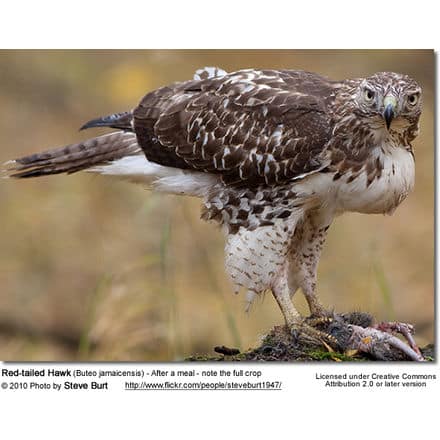
Use in Falconry
As they are so common and easily trained, most hawks captured for falconry are Red-tailed Hawks.
In the United States the sport of falconry is tightly regulated at both the federal and state levels. There are fewer than 5,000 falconers in the United States.
Falconers are only permitted to take passage hawks (which have left the nest, are on their own, but are less than a year old); so as to not affect the breeding population.
It is against the law to take adults, which may be breeding or raising young.
Falconers also prefer young birds, as they are easier to train.
